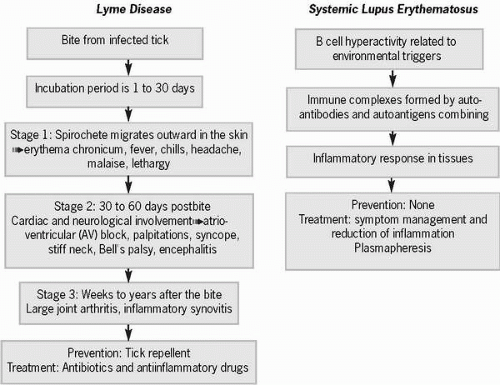Lyme Disease and Systemic Lupus Erythematosus
Lyme disease was first identified in 1975 in Old Lyme, Connecticut. Some deer and small mammals such as mice carry Ixodidae ticks, which act as a reservoir for the spirochete Borrelia burgdorferi and cause Lyme disease in humans. Lyme disease is the most common tickborne illness in the United States. If a person is bitten by an infected tick that remains attached to the skin for at least 24 hours, the spirochete is transmitted and produces endotoxins that cause an inflammatory process involving the skin, musculoskeletal system, and central nervous system. This spirochete may remain localized at the site of the tick bite or may invade any tissue, accounting for the variety and severity of symptoms presented.
Systemic lupus erythematosus (SLE) is a chronic, multisystem, inflammatory disease of unknown cause affecting approximately 500,000 people in the United States. This is a disease that mainly affects young adult women, with African Americans, Hispanics, and Asians affected more than whites.
Pathophysiology
There are three stages of infection with Lyme disease. After an incubation period of 1 to 30 days, stage one occurs when the spirochete migrates outward in the skin, resulting in the appearance of erythema chronicum migrans, the characteristic “bull’s eye” rash some infected people develop. This expanding rash has a clear center at the site of the bite surrounded by a red ring and may reach
a diameter of 50 cm. During this stage the spirochete may also spread to other sites by way of the lymph or blood. Other symptoms of the initial infection include fever and chills, headache, malaise, and lethargy. If the infection is undetected or untreated the disease becomes chronic, and cardiac and neurological involvement occur 2 to 3 months after the bite as part of the second stage of the disease. Symptoms of this stage of the infection include severe atrioventricular block, palpitations, syncope, stiff neck, photophobia, Bell’s palsy, fatigue, encephalitis, and radiculoneuritis (i.e., inflammation of spinal nerves, producing pain and increased sensation) that can last 6 months or longer. If untreated, approximately 70% of people infected with Lyme disease develop arthritis, primarily of large joints as part of the third stage of the disease within weeks to years after the initial infection. Arthritis associated with Lyme disease may be in the form of arthralgia or, in 10% of people, a chronic inflammatory synovitis. The third stage of the disease is thought to be the result of treatment failure, relapses caused by persistent infection, or possibly an autoimmune reaction to the spirochete.
a diameter of 50 cm. During this stage the spirochete may also spread to other sites by way of the lymph or blood. Other symptoms of the initial infection include fever and chills, headache, malaise, and lethargy. If the infection is undetected or untreated the disease becomes chronic, and cardiac and neurological involvement occur 2 to 3 months after the bite as part of the second stage of the disease. Symptoms of this stage of the infection include severe atrioventricular block, palpitations, syncope, stiff neck, photophobia, Bell’s palsy, fatigue, encephalitis, and radiculoneuritis (i.e., inflammation of spinal nerves, producing pain and increased sensation) that can last 6 months or longer. If untreated, approximately 70% of people infected with Lyme disease develop arthritis, primarily of large joints as part of the third stage of the disease within weeks to years after the initial infection. Arthritis associated with Lyme disease may be in the form of arthralgia or, in 10% of people, a chronic inflammatory synovitis. The third stage of the disease is thought to be the result of treatment failure, relapses caused by persistent infection, or possibly an autoimmune reaction to the spirochete.
 Lyme disease is the most common tickborne illness in the United States.
Lyme disease is the most common tickborne illness in the United States.Stay updated, free articles. Join our Telegram channel

Full access? Get Clinical Tree


Get Clinical Tree app for offline access

